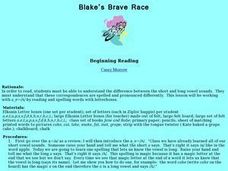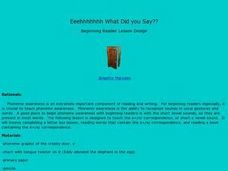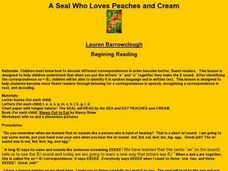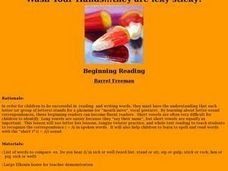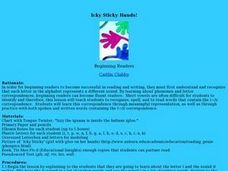Curated OER
Blake's Brave Race
Students distinguish the difference between the short and long vowel sounds. They practice correspondences that are spelled and pronounced differently working with a_e=/A/ vowel sounds. Elkonin Letter boxes and class set of books are...
Curated OER
It's Icky Icky Sticky
Learners recognize the short vowel i in written and spoken language. Through listening and matching activities, they discriminate the vowel sound /i/ from other phonemes. Students identify the phoneme and letter in pseudo words they decode.
Curated OER
It's Icky Sticky
Students recognize the short vowel a in written and spoken language. Through matching and listening activities, they discriminate the vowel sound /a/ from other phonemes. Students identify the phoneme and letter in pseudo words they decode.
Curated OER
Can You Open the Creaky Door?
Students recognize the short vowel e in written and spoken language. Through matching and listening activities, they discriminate the vowel sound /e/ from other phonemes. Students identify the phoneme and letter in words and pictures.
Curated OER
Icky Sticky
Young scholars recognize the short vowel i in written and spoken language. Through matching and listening activities, they discriminate the vowel sound /i/ from other phonemes. Students identify the phoneme and letter in pseudo words...
Curated OER
Up, Up and Away
Students recognize the short vowel u in written and spoken language. Through matching and listening activities, they discriminate the vowel sound /u/ from other phonemes. Students identify the phoneme and letter in words and pictures.
Curated OER
Open Wide and Say Ahh
Students recognize the short vowel o in written and spoken language. Through matching and listening activities, they discriminate the vowel sound /o/ from other phonemes. Students identify the phoneme and letter in words and pictures.
Curated OER
Pooh's Rumbling Tummy
Students recognize the short vowel u in written and spoken language. Through matching and listening activities, they discriminate the vowel sound /u/ from other phonemes. Students identify the phoneme and letter in words and pictures.
Curated OER
Scary Scary....aaaaa!!!
Students study the /a/ in both written and spoken word by reciting a tongue twister in which they exaggerate the /a/. Next, the make given words using letterboxes after the teacher models the technique, Next, they read "Pat's Jam" to a...
Curated OER
Shelly Shark Goes Shopping
Students identify the digraph /sh/ in written and spoken language. Students practice the production of the /sh/ sound through words and tongue twisters. They identify the initial and final placement of the new digraph /sh/ through...
Curated OER
Say What?
Students explore phonemes in spoken words. They discuss the /e/ (short e) correspondence. Students read "Red Gets Fed." They learn a meaningful letter symbol for the /e/. Students identify /e/ sound in both spoken and written words.
Curated OER
"Loud Cows All Around"
Students practice with vowel digraphs and how letters can correspond with phonemes. The lesson consists of students learning the ou=/ow/ correspondence in which they will learn in both spoken and written words through reading and...
Curated OER
Ow! That Hurts!
Students identify the diagraph of ow coming together to make one sound. They read words containing this diagraph and spell words too. In the story, The Napping House, each pair of students finds -ow words. As an assessment, students...
Curated OER
"OU" O U Hurt Me!
Students explore the digraph ou=/ow/ in written and spoken words. They practice writing words with the ou=/ow/ digraph. Students match phonemes in words they hear. Students read The Napping House and identify words with the ou=/ow/ digraph.
Curated OER
Howwwwl At The Moon
Students explore vowel digraphs. They discuss what a vowel digraph is and discuss the vowel digraph ou=/ow/. Students read "The Napping House." They practice spelling words with the /ow/ sound in them. Students read words with the /ow/...
Curated OER
Eeehhhhhhh What Did you Say??
Student read pseudo words containing the e=/e/ correspondence and recognize sounds in vocal gestures and words. They explore the e=/e/ correspondence, or short e vowel sound and complete a letter box lesson, reading words that contain...
Curated OER
Unopened Umbrella
Students explore vowel correspondences. They discuss the vowel correspondence u=/u/. They identify u=/u/ in written words and a meaningful representation and letter symbol for the sound. Students read and write words using u=/u/.
Curated OER
Shiny Shells on the Shore
Students investigate how: A single phoneme, which is a vocal gesture in spoken words, can be represented by more than one grapheme. Also how a digraph is the combination of two letters that make one sound (there are both vowel and...
Curated OER
A Seal Who Loves Peaches and Cream
Students decode correspondence in order to become better, fluent readers. When the letters e and a are put together they make the E sound. They become more fluent readers through listening for a correspondence in speech, in text, and...
Curated OER
U-u-under The U-u-umbrella!
Students practice using phonemes because they need to be able to recognize that phonemes and letters correspond with each other in order to become a proficient reader. The practice is done using the letter "u".
Curated OER
Opera Singer
Students recognize the short vowel o in written and spoken language. Through listening and decoding activities, they discriminate the vowel sound /o/ from other phonemes. Students identify the phoneme and letter in pseudo words they read.
Curated OER
Wash Your Hands...they are icky sticky!
Students engage in an emergent literacy lesson that focuses on phonemic awareness and they practice corresponding the letter "i" to its long or short sound. This type of recognition has been found to be essential to reading development.
Curated OER
O-O-O-O-O, I get it!
Students engage in an emergent literacy instructional activity that focuses on the skill of phonemic awareness. To practice the skill the phoneme for the letter "o" is used. The students need to recognize the letter and its corresponding...
Curated OER
Icky Sticky Hands!
Students examine the letter 'i'. Through instruction and modeling they explore the sound the letter makes, how the letter is written, words that contain the letter, etc. They use letterboxes to write 'i' words and read stories containing...


